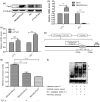Differential effects of Pax3 on expression of polysialyltransferases STX and PST in TGF-β-treated normal murine mammary gland cells
- PMID: 27651434
- PMCID: PMC5167121
- DOI: 10.1177/1535370216669838
Differential effects of Pax3 on expression of polysialyltransferases STX and PST in TGF-β-treated normal murine mammary gland cells
Abstract
Glycosylation of certain proteins at the mammalian cell surface is an essential event in carcinogenesis. Sialylation, one type of glycosylation, can act on multiple cell-behaviors, such as migration, growth, and malignant invasion. Two polysialyltransferases, ST8Sia II (STX) and ST8Sia IV (PST), are responsible for synthesis of polysialic acid on neural cell adhesion molecule. We showed previously that STX and PST are oppositely expressed in normal murine mammary gland cells undergoing transforming growth factor-β-induced epithelial-mesenchymal transition. The molecular basis for regulation of STX and PST remained unclear. In the present study, we observed that transcription factor Pax3 upregulates STX expression, downregulates PST expression, and modulates upregulated expression of PSA, which attaches primarily to neural cell adhesion molecule to form PSA-NCAM. Overexpression of Pax3 in normal murine mammary gland cells transformed the expression of epithelial-mesenchymal transition markers E-cadherin and N-cadherin, and significantly promoted cell migration, but had no effect on cell proliferation.
Keywords: PSA-NCAM; PST; Pax3; STX; epithelial-mesenchymal transition; polysialyltransferase.
Figures




Similar articles
-
Differential and cooperative polysialylation of the neural cell adhesion molecule by two polysialyltransferases, PST and STX.J Biol Chem. 1998 Oct 23;273(43):28524-32. doi: 10.1074/jbc.273.43.28524. J Biol Chem. 1998. PMID: 9774483
-
The polysialyltransferase ST8Sia II/STX: posttranslational processing and role of autopolysialylation in the polysialylation of neural cell adhesion molecule.Glycobiology. 2001 Nov;11(11):997-1008. doi: 10.1093/glycob/11.11.997. Glycobiology. 2001. PMID: 11744634
-
Promotion of cell migration by neural cell adhesion molecule (NCAM) is enhanced by PSA in a polysialyltransferase-specific manner.PLoS One. 2015 Apr 17;10(4):e0124237. doi: 10.1371/journal.pone.0124237. eCollection 2015. PLoS One. 2015. PMID: 25885924 Free PMC article.
-
Polysialyltransferases: major players in polysialic acid synthesis on the neural cell adhesion molecule.Biochimie. 2003 Jan-Feb;85(1-2):195-206. doi: 10.1016/s0300-9084(03)00051-8. Biochimie. 2003. PMID: 12765789 Review.
-
3D structural conformation and functional domains of polysialyltransferase ST8Sia IV required for polysialylation of neural cell adhesion molecules.Protein Pept Lett. 2015;22(2):137-48. doi: 10.2174/0929866521666141019192221. Protein Pept Lett. 2015. PMID: 25329332 Review.
Cited by
-
Biological Functions and Analytical Strategies of Sialic Acids in Tumor.Cells. 2020 Jan 22;9(2):273. doi: 10.3390/cells9020273. Cells. 2020. PMID: 31979120 Free PMC article. Review.
-
Enhanced motility and proliferation by miR-10b/FUT8/p-AKT axis in breast cancer cells.Oncol Lett. 2018 Aug;16(2):2097-2104. doi: 10.3892/ol.2018.8891. Epub 2018 Jun 4. Oncol Lett. 2018. PMID: 30008906 Free PMC article.
References
-
- Li M, Song L, Qin X. Glycan changes: cancer metastasis and anti-cancer vaccines. J Biosci 2010; 35: 665–73. - PubMed
-
- Troy FA. Polysialylation: from bacteria to brains. Glycobiology 1992; 2: 5–23. - PubMed
-
- Doherty P, Cohen J, Walsh FS. Neurite outgrowth in response to transfected N-CAM changes during development and is modulated by polysialic acid. Neuron 1990; 5: 209–19. - PubMed
-
- Muller D, Wang C, Skibo G, Toni N, Cremer H, Calaora V, Rougon G, Kiss JZ. PSA–NCAM is required for activity-induced synaptic plasticity. Neuron 1996; 17: 413–22. - PubMed
-
- Ong E, Nakayama J, Angata K, Reyes L, Katsuyama T, Arai Y, Fukuda M. Developmental regulation of polysialic acid synthesis in mouse directed by two polysialyltransferases, PST and STX. Glycobiology 1998; 8: 415–24. - PubMed
Publication types
MeSH terms
Substances
LinkOut - more resources
Full Text Sources
Other Literature Sources
Research Materials
Miscellaneous

